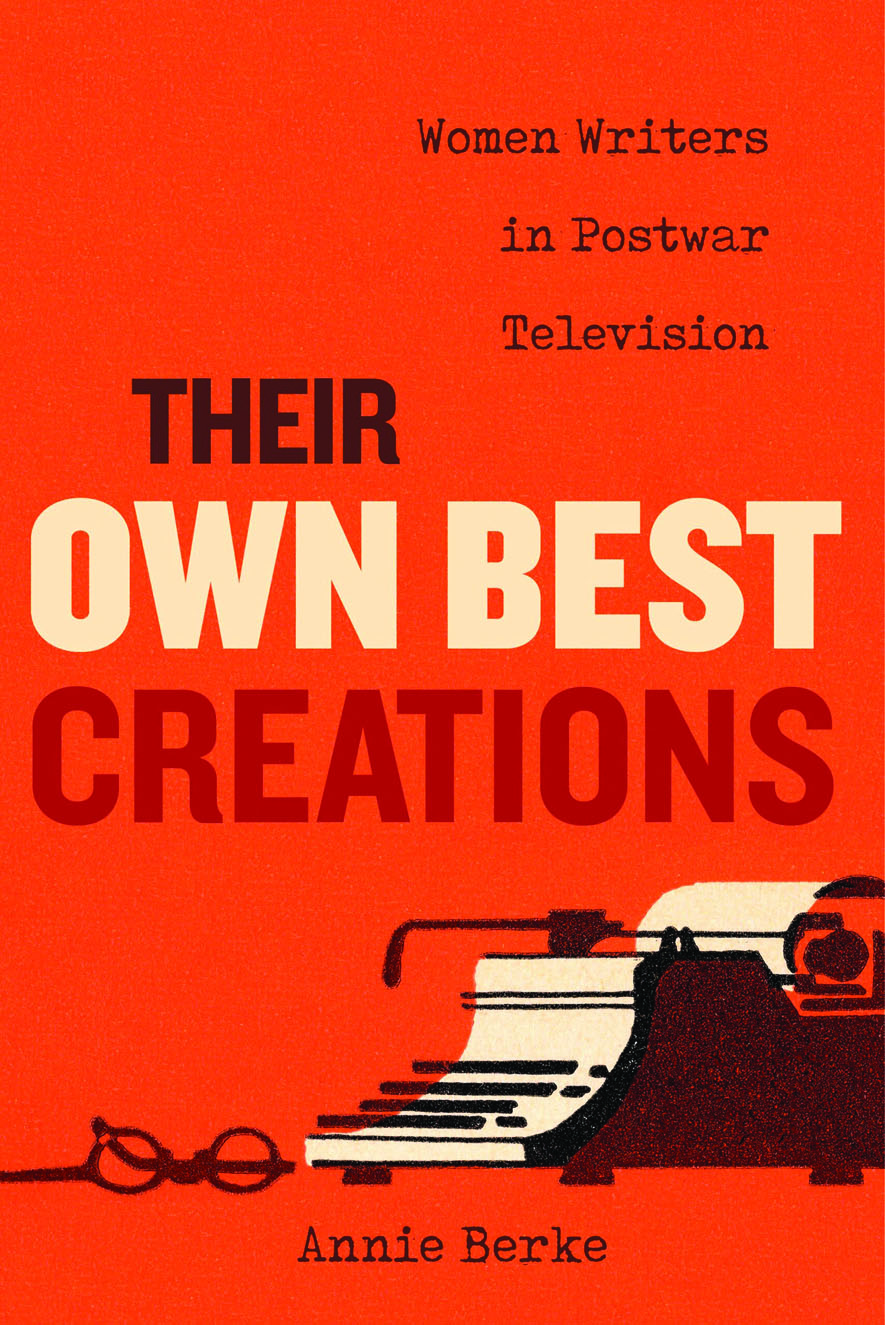From literature to television, American culture has idealized the image of the male author. In Their Own Best Creations: Women Writers in Postwar Television, Annie Berke not only provides alternative models to the romanticized male author, but she also looks at women’s producing, administrative, and clerical work to demonstrate how women shaped the stories, humor, and voices of postwar television. By reorienting ideas about texts to include both scripts and the personae of writers, Berke has ample material to analyze and understand postwar female authorship. Drawing on writers who worked in both film and radio, Berke’s book will pique the interest of radio and television scholars, but her conceptual frameworks and innovative use of texts alongside industrial history make it essential reading for students and scholars of media industries and labor.
Scholarly interest in industrial diversity is typically fueled by a desire to see more diversity on-screen, yet it is unusual to find scholarly works that use creative work to understand individual working conditions. Berke highlights her approach to postwar screenwriters early in the book when she explains:
Although scholarship on labor and production cultures typically relies on archival material, interviews, or oral histories to center worker’s voices, Berke treats scripts as “self-ethno graphic,” which helps her bridge gaps in the archives, add texture to the stories of these women’s lives, and consider how their creative work mediated female writers’ personal and professional concerns.2 By including a persona as part of a writer’s creative output (“their own best creations”), Berke implicitly embraces a familiar star studies framework that allows for analysis of gendered labor challenges that might not be explicit in the archival material.The woman writing for television in this period serves as an occasion for theorizing the relationship between production culture (industry workings and lived experiences) and cultural production (media texts), as well as how a writer’s persona bridges these distinctions in establishing a publicly visible scripted life.1
Their Own Best Creations tells some familiar tales of sexism in the television industry. From macho locker room talk (chapter 1) to the erasure of credit (chapter 5), some of the examples Berke provides resonate throughout television history. Since individual chapters also theorize television form and genres, it is easy to see how they could stimulate discussion in television history and studies courses; however, for industry scholars interested in its contribution to feminist industry studies, reading the full book is the best way to get a sense of the various gendered dynamics at play for women working in television.
Writing about the varied histories of female television writers, Berke reminds us: “Each woman’s story is inflected by how they were hired, whether they found allies in their place of work or with a devoted fan base, and if their contributions were institutionally rewarded.”3 Although this comment specifically references the challenges of understanding women’s experiences through archival research, it is a conclusion that is deeply felt in the accumulation of the experiences in body chapters. The chapters focusing on individual writers, or multi-hyphenates (before this was a term), such as Lucille Kallen (chapter 2), Gertrude Berg and Peg Lynch (chapter 3), and Irna Phillips (chapter 4), offer deeper readings of their careers and help situate how each of these women negotiated their gender in the workplace. Gendered writing room dynamics (chapter 1), the centrality of clerical roles to screenwriting (chapter 5), and the importance of women writers in anthology dramas (chapter 6) provide a broader framework for workplace dynamics. Many readers (myself included) will undoubtedly feel some of Berke’s conclusions resonate with their own professional experiences. Those who have read Joyce Chopra’s 2022 autobiography Lady Director will also recognize the same dynamics at play. Chopra’s growth as a director, like the careers of many of Berke’s subjects, frequently hinged on her ability to negotiate gendered expectations across multiple decades.
Berke’s theoretical maneuvers offer an inventive expansion on some of the other excellent work on screenwriters. Writing about screenwriters and their union, Miranda Banks points out that “writers speak about themselves and about their community in lucid, articulate terms.”4 Perhaps because of this skill, histories of writers have been told more frequently than other media professions.5 Based on the number of existing books about screenwriters and their craft, it would be easy to assume that writers have been skilled at creating an archival trail for scholars to follow, even if this is not always true. Several of the women Berke focuses on have been the subject of previous biographies and works of television studies, but by combining these sources with archival material she is able to paint a more vivid picture of these women’s work and lives.
Their Own Best Creations is not purely a recuperative industry history. As she notes, researching women’s histories often means dealing with incomplete archives, and as such, cultural products help to bridge gaps and provide additional sources for insights. Some of Berke’s inventive uses of archival material might have been borne out of necessity, but the result is a book that is impressive in the array of evidence it uses to make key points. For example, labor histories don’t often include analyses of scripts. Although Berke analyzes the work of many women writers, there is a particular section (chapter 3) in which she compares a scene from Paddy Chayefsky’s oft-lauded Marty to a scene from Peg Lynch’s Ethel and Albert. Rather than solely describing these scenes, Berke includes each page of dialogue for the reader to compare not only the content but also the rhythms.6 Throughout the book, Berke interrogates structures (such as the Criterion Collection) that elevate the masculine television writing of the Golden Age, but this textual comparison is more convincing than asking prodding questions of taste-making entities and “common sense” ideas about high and low forms of television.
Whereas industry studies of labor often consider professional identity, Berke asks different sets of questions that are as much about the contexts of production as the workers themselves. Part of her analysis focuses on women writing for different television genres (comedy, drama, and mystery/thriller) that were frequently considered less prestigious than some of the esteemed anthology shows of the time. The cultural status of each show and genre also becomes ripe for interrogation as part of her broader examination of each production culture. In the process of challenging the TV canon, Berke reframes the cultural legacy of famed writers’ rooms from the female perspective. This approach is particularly effective in chapter 2, which focuses on Sid Caesar’s The Show of Shows. Although this writers’ room has long been described as a fraternity house environment, the image of its culture is rendered more grotesque when told from the perspective of Lucille Kallen.
As many labor scholars, and especially feminist labor scholars understand, reflecting on labor conditions in the media industries (past and present) can be frustrating for those committed to a more equitable future. Berke reminds us that the importance of understanding these histories is “crucial for seeing how these legacies continue into our present.”7 While stories of struggles can be difficult, Berke’s citational practice is a comforting reminder of just how many scholars and workers care about changing the status quo. Their Own Best Creations is both a work of feminist television history and an object lesson in the adage that “citation is political.” Berke invites the reader into feminist television studies, but generously includes scholarship across the history of feminist media studies within this rich conversation. In her conclusion, Berke reminds readers that the “historians’ additional responsibility lies in setting up appropriate, ambitious benchmarks for progress … without treating the industry as a static entity or a ‘monolith.’ ”8 I could not agree more with this sentiment, and while there is much to lament about the state of the media industries, I am heartened by projects like this, which carry on the tradition of feminist media history, while articulating its continued value for the present and calling for more accountability and nuanced assessment of Hollywood’s diversity projects.
Notes
- Annie Berke, Their Own Best Creations: Women Writers in Postwar Television (Berkeley: University of California Press, 2022), 13. ⮭
- Ibid., 5. ⮭
- Ibid., 47. ⮭
- Miranda Banks, The Writers: A History of American Screenwriters and Their Guild (New Brunswick: Rutgers University Press, 2015), 233. ⮭
- Book length studies about writers include: Banks, The Writers; Larry Ceplair and Steven Englund, The Inquisition in Hollywood: Politics in the Film Community, 1930–1960 (Urbana: University of Illinois Press, 2003); Catherine Fisk, Writing for Hire: Unions, Hollywood, and Madison Avenue (Cambridge: Harvard University Press, 2016); Patricia Phelan, Writing Hollywood: The Work and Professional Culture of Television Writers (New York: Routledge, 2018); Nancy Lynn Schwartz, The Hollywood Writers’ Wars (New York: McGraw-Hill, 1982). ⮭
- Berke, Their Own Best Creations, 91–92. ⮭
- Ibid., 206. ⮭
- Ibid., 223. ⮭
Kate Fortmueller is an assistant professor at the University of Georgia. Her writing about film and television labor has appeared in journals including Film History, the Historical Journal of Film, Radio, and Television, and Media Industries Journal. She is the author of Below the Stars: How actors and extras helped shape the landscape of production and Hollywood Shutdown: Production, Distribution, and Exhibition in the Time of COVID (both University of Texas Press, 2021).


